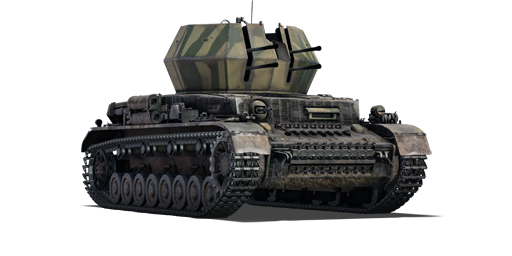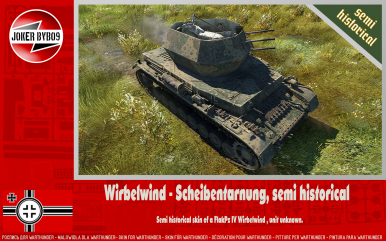



The Flakpanzer IV "Wirbelwind" (Sd.Kfz. Index: Sd.Kfz. 161/4) is the first variant of the Flakpanzer IV self-propelled anti-aircraft gun family. The German military forces were less interested in developing self-propelled anti-aircraft guns in the early years of World War II, but as the Allies gained air superiority, the need for more mobile and better-armed self-propelled anti-aircraft guns grew. SS-Hauptsturmführer Karl Wilhelm Krause of the 12th SS Panzer Division Hitlerjugend came up with the Flakpanzer IV Wirbelwind concept in the early summer of 1944. He presented the idea to SS-Obersturmbannführer Max Wünsche, commanding officer of the 12th SS Panzer Regiment, and Adolf Hitler approved it. The Panzer IV medium tank chassis was used to mount an open-top, nine-sided turret housing a quadruple mount of 20 mm Flugzeugabwehrkanone 38 autocannon (Flakvierling 38). A closed-top design would have been preferable, but due to the heavy smoke generated by the main armament, this was not possible. The turret's shape earned it the nickname Keksdose ("biscuit tin"). Ostbau Werke in Sagan, Silesia, was primarily responsible for its construction.
Introduced in Update 1.43, the Flakpanzer IV "Wirbelwind" is one of the best self-propelled anti-air vehicles in its class. Given its high fire rate, this machine effectively spews out a stream of fragmentation rounds, and any plane unfortunate enough to be hit by the waves of shells will burst into flames if not being completely destroyed. However, crews inside the turret are only marginally protected by thin armour, so it is critical to keep an eye out for enemy aircraft strafing. Lastly, armour-piercing ammunition belts are also available to destroy lightly armoured targets.
| Belt | Belt filling | Armor penetration (mm) at a distance: | |||||
|---|---|---|---|---|---|---|---|
| 10 m | 100 m | 500 m | 1000 m | 1500 m | 2000 m | ||
| API-T/HEFI-T/HEFI-T/HEFI-T | 37 | 34 | 23 | 14 | 9 | 6 | |
| HEFI-T | 5 | 4 | 3 | 3 | 3 | 3 | |
| API-T | 37 | 34 | 23 | 14 | 9 | 6 | |
| HVAP-T/API-T | 48 | 45 | 31 | 20 | 13 | 8 | |












Mobility | |
|---|---|
Protection |
|---|
Firepower | |
|---|---|
